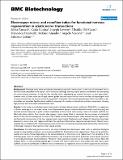Electrospun micro- and nanofiber tubes for functional nervous regeneration in sciatic nerve transections
Author(s)
Panseri, Silvia; Cunha, Carla; Lowery, Joseph L.; Del Carro, Ubaldo; Taraballi, Francesca; Amadio, Stefano; Vescovi, Angelo; Gelain, Fabrizio; ... Show more Show less
Download1472-6750-8-39.pdf (3.623Mb)
PUBLISHER_CC
Publisher with Creative Commons License
Creative Commons Attribution
Terms of use
Metadata
Show full item recordAbstract
Background: Although many nerve prostheses have been proposed in recent years, in the case of consistent loss of nervous tissue peripheral nerve injury is still a traumatic pathology that may impair patient's movements by interrupting his motor-sensory pathways. In the last few decades tissue engineering has opened the door to new approaches;: however most of them make use of rigid channel guides that may cause cell loss due to the lack of physiological local stresses exerted over the nervous tissue during patient's movement. Electrospinning technique makes it possible to spin microfiber and nanofiber flexible tubular scaffolds composed of a number of natural and synthetic components, showing high porosity and remarkable surface/volume ratio. Results: In this study we used electrospun tubes made of biodegradable polymers (a blend of PLGA/PCL) to regenerate a 10-mm nerve gap in a rat sciatic nerve in vivo. Experimental groups comprise lesioned animals (control group) and lesioned animals subjected to guide conduits implantated at the severed nerve stumps, where the tubular scaffolds are filled with saline solution. Four months after surgery, sciatic nerves failed to reconnect the two stumps of transected nerves in the control animal group. In most of the treated animals the electrospun tubes induced nervous regeneration and functional reconnection of the two severed sciatic nerve tracts. Myelination and collagen IV deposition have been detected in concurrence with regenerated fibers. No significant inflammatory response has been found. Neural tracers revealed the re-establishment of functional neuronal connections and evoked potential results showed the reinnervation of the target muscles in the majority of the treated animals. Conclusion: Corroborating previous works, this study indicates that electrospun tubes, with no additional biological coating or drug loading treatment, are promising scaffolds for functional nervous regeneration. They can be knitted in meshes and various frames depending on the cytoarchitecture of the tissue to be regenerated. The versatility of this technique gives room for further scaffold improvements, like tuning the mechanical properties of the tubular structure or providing biomimetic functionalization. Moreover, these guidance conduits can be loaded with various fillers like collagen, fibrin, or self-assembling peptide gels or loaded with neurotrophic factors and seeded with cells. Electrospun scaffolds can also be synthesized in different micro-architectures to regenerate lesions in other tissues like skin and bone.
Date issued
2008-04Department
Massachusetts Institute of Technology. Institute for Soldier Nanotechnologies; Massachusetts Institute of Technology. Department of Chemical EngineeringJournal
BMC Biotechnology
Publisher
BioMed Central Ltd
Citation
BMC Biotechnology. 2008 Apr 11;8(1):39
Version: Final published version
ISSN
1472-6750